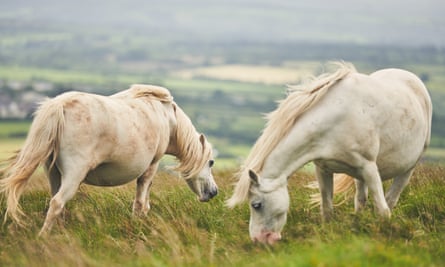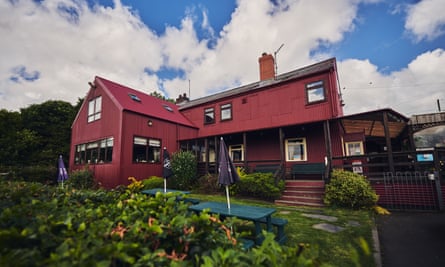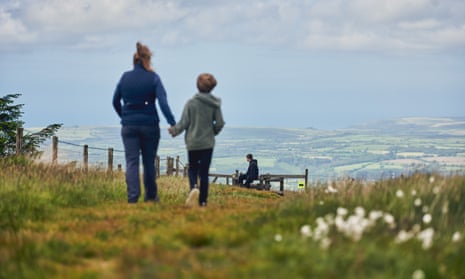Here’s something that not too many people know – Pembrokeshire, famed for its coastline, also has one of the finest viewpoints in southern Britain. Foel Cwmcerwyn, in the Preseli Hills, may be quite modest in altitude, but on a clear day it offers a superb view over three countries. Its 536-metre summit can be reached relatively easily and is the high point of this walk.
I do this walk regularly, always setting off from the delightfully named Rosebush village, which has nothing to do with roses but is probably an anglicisation of Rhos-y-bwlch, meaning a gap in the moors.
The village developed in the mid-19th century when houses were built for workers at the local slate quarry. It provided the slates for the roof of Westminster Palace, but the quarry had closed by 1908.

I take the footpath opposite the telephone box in the village (apparently a listed “building”), heading uphill to the left of Pantmawr farm until I reach a well-marked track, where I turn left and continue uphill to the summit of Foel Cwmcerwyn. It’s a pretty stiff climb, much of it alongside the dark-green conifers of Pantmaenog Forest, with the steepest section at the very top where you rise above the treeline, and it can be soggy in places. Today, however, I barely get my boots wet as west Wales has enjoyed an unusually long dry spell.

As I ascend, the views south become ever more expansive, and stopping to admire Pembrokeshire’s bucolic landscape, indented coastline and offshore islands always provides a good excuse for a breather. But things get even better when I reach the trig point on the summit. The northerly breeze that’s been blowing for the past few days has cleared the clouds and left a dazzling blue sky.
I can see across Cardigan Bay to the hazy blue mountains of Snowdonia in the north, and to the south over all of Pembrokeshire and the distant hills of Exmoor. To my east is Worm’s Head on the Gower peninsula, and faintly visible as small bumps above the Irish Sea to the west are Ireland’s Wicklow mountains. Three countries in one view.

These hills, modest in height though they are, have the kind of wild, epic quality that provided an apt setting for King Arthur and his knights’ battle with the giant magic boar Twrch Trwyth – at least that’s what The Mabinogion, the book of ancient Welsh folk tales, would have us believe.
Indeed, a palpable sense of the past infuses this whole landscape – my walk follows a gentle northerly descent on to the Golden Road, a 5,000-year-old trail along the spine of the Preseli Hills that passes standing stones, iron age forts and the site from which the bluestones of Stonehenge were quarried.
I turn west on to the Golden Road (which means I won’t be seeing the standing stones as they’re to the east), enjoying the sensation of having much of Wales laid out beneath me as I pass a small and frisky herd of wild ponies, manes sun-bleached and shaggy, before dropping into the shade of Pantmaenog forest through a gate at Bwlch Pennant.
It’s now an easy descent on forest fire roads and bridleways, some of which have been made into one of the few signposted mountain-bike trails in Pembrokeshire, not that I see any mountain bikers today; indeed, as I’ve chosen to do the walk on a weekday I’ve only seen two other people since I set off.

Eventually emerging from the forest, I walk past the dark and craggy remnants of Rosebush Quarry, which is now flooded and in recent years has become popular for swimming among hardy souls who can tolerate the icy cold water.
For the arrow-straight final few hundred metres of the walk, I’m striding parallel with what was once a railway line used to shift slate from the quarry; it was opened in 1876, then closed and reopened three times between 1883 and 1895, by which time the idea of setting up Rosebush as a spa had taken hold, only to quickly fade when it was realised the local waters had no particular beneficial health effects. The fact that Rosebush is also a long way from anywhere probably didn’t help.
The line finally closed to passengers in 1937 and freight in 1949 – now all that remains is a slightly eerie montage of mannequins in period clothing masquerading as rail passengers on the platform of the old station, which, by happy coincidence, is right next to Tafarn Sinc, where I end my walk with a pint of locally brewed ale.
Start Rosebush village
Distance 5 miles
Time 2½-3 hours
Total ascent 287 metres
Difficulty Moderate
Google map of the route
This article includes content provided by Google. We ask for your permission before anything is loaded, as they may be using cookies and other technologies. To view this content, click 'Allow and continue'.
The pub

Tafarn Sinc (Zinc Tavern) dates back to 1876 and, despite the name, is actually constructed from sheets of corrugated iron. The building was originally called the Precelly hotel (an alternative spelling of Preseli) and served local inhabitants and rail passengers, not taking on its Welsh appellation until the 1990s.
Walkers crossing the sawdust-strewn floor to the bar will find huge flitches of ham hanging from the rafters, with ancient agricultural implements and old black and white photographs adorning the walls to give a very rustic feel.
They should be thankful that the pub is here at all – it was set to close in 2017 but after enthusiastic campaigning by locals (including actor Rhys Ifans, born in nearby Haverfordwest), a buyout was organised and Tafarn Sinc now operates as a community-owned pub.

I’ve always received a very warm welcome here, when either walking with my border collie (dogs are welcome) or splattered in mud after a mountain bike ride. A lunchtime pint along with a bite to eat from a menu that focuses on local produce (homemade minted lamb as well as rarebit burgers, vegetarian leek and Caerphilly cheese sausages) plus the usual pub favourites is the perfect conclusion to this walk.
tafarnsinc.cymru
Where to stay
A two-minute walk from Tafarn Sinc is Rosebush holiday park, which is on the site of the would-be spa development of Victorian times and centred around an ornamental pond built in 1876. There’s the option of camping pods or log cabins, and pitches for campervans, motorhomes and caravans.
Camping pods (sleep two, minimum two nights) and log cabins (sleep four) from £50 a night; touring vehicles from £25 a night, rosebushholidaypark.co.uk
